Despite the promises of the communists, the proclamation of the People's Republic of China did not mean the end of suffering for the citizens of the Middle Kingdom. Soon hunger pushed many of them to reach for human flesh. Cannibalism did not disappear later either - it turned from an act of desperation into a method of revenge against the "enemies of the people".
The festival of blood, murder and hunger has a rich tradition in the Middle Kingdom. It was no different in the 20th century. The very rivalry between nationalists and communists led to the death of millions of citizens. When Mao Zedong solemnly announced the founding of the People's Republic of China on October 1, 1949, the situation seemed to calm down. Unfortunately, exactly the opposite happened. Slaughter on an unprecedented scale broke out in the country. But the worst was yet to come ...
The Great Leap Forward
Communist experiments began almost immediately after the end of the civil war. However, the plan of industrialization of the Middle Kingdom did not bring the expected results. Then, in 1957, a crazy concept was born in Mao Zedong's mind that went down in history as the Great Leap Forward.
Mao demanded that individual farms be merged into people's communes in which all goods will be common. He also recommended that more cereals should be planted. In his opinion, this should be the way to multiply the crop. The chairman also came up with the idea of creating thousands of primitive earth furnaces for smelting steel. He imagined that 12 million tons of steel would be produced this way by the end of 1958. He also hoped that by 1962 this number would increase to ... 100 million!
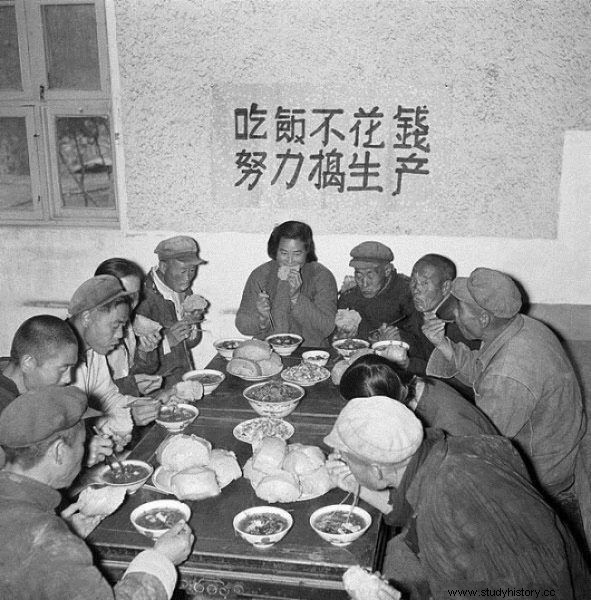
photo:public domain Initially, meals were distributed for free in communal canteens. After only a few months of the Great Leap Forward, the food was over and there was a famine all over the country.
The effect of these experiences was predictable. The peasants, driven from the fields to work in smelting steel, were deprived of the possibility of cultivating the land. They were unable to stockpile food for the winter. The nationwide madness in the production of "pig iron" deprived them of even the dishes in which they could prepare their meals. All of them went to the furnaces. Just a few months after the inauguration of the Great Leap Forward, there were clear signs of crisis. Soon people just ran out of food. Alarming reports began pouring over Mao's desk. Poverty and hunger were rampant in the country.
"Parents had to decide who would die first"
The first attacks on grain warehouses and organized robbery of trains took place at the turn of 1957 and 1958. The stocks in the villages ran out, and the marketplaces in the cities were silent, because there were no more agricultural produce on the market. People, desperate to survive, ate grass, bark, and rats. The hunger was getting stronger. Eventually, their eyes began to turn to people. The weakest units - children - were the first to fall victim. In the book "Mao. An empire of suffering ” Torbjørn Færøvik presents the situation in the country with the example of one region:
In Anhui Province, Mao's experiments ended in a hell of suffering and death. Official party documents show that entire villages were starving. Those who survived the longest ate each other. The worst part was that the parents had to decide who would die first, the report said. - Usually the youngest girls were chosen, boys lived the longest.
Worse still, the specter of subsequent years of defeat became more and more real. The peasants were so exhausted from working in the fields or smelting steel that by 1959 many crops were left undeveloped. People were forced to fight for food and only the strongest had a chance of survival.
At the same time, practices developed that apparently at least reduced the monstrosity of the crimes that were taking place throughout the country. Parents who were unable to break down to eat their own child collaborated with their neighbors. A shocking description of the yi ze er shi strategy (switching children for food) is included in Torbjørn Færøvik's book:
A mother said to her daughter:"Soon you will visit your grandmother in heaven". Then she stopped feeding her. She only got water. When the girl was dying, she was exchanged for the dead daughter of the neighbors . So that parents do not have to eat their own child. They cooked meat and made soup on it.
Did the Chinese leader know what was happening in the provinces as a result of implementing his criminal policy? Yes. However, this did not interest him. Sam ate savory dishes every day, and the appropriate group of subordinates took care of satisfying his cravings. He had nothing to complain about.
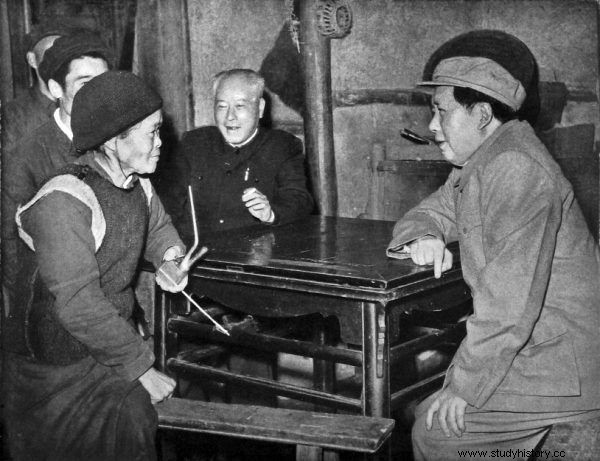
The Chinese people thought Mao did not know what was happening in the country and still trusted him. The photo shows a meeting with the inhabitants of the province from 1958.
The classified Big Leap balance sheet
Meanwhile, the citizens of the People's Republic of China were convinced that Comrade Mao knew nothing. Peasants sent letters to Beijing with claims and complaints about the conditions in the provinces. However, it did not help. The famine continued for months and the country's leaders did nothing to remedy it. This is how the witnesses of those dark times recall the consequences of implementing the paranoid concept of the chairman:
My daughter is married to a man from a village on the other side of the mountain. Last week she came to us and said that in her village many girls were killed and eaten. [...] In one of the production brigades, peasants killed and ate 48 girls under the age of seven. 82 families belonged to the brigade, with a total of 490 members. Brigade accountant Wang Jiefang said they all ate grass, leaves, roots and mushrooms for a long time. And that they eventually became cannibals out of despair.
Estimates say a minimum of 10 million victims of the Great Leap Forward, but there are also figures that mention a figure four times as high. How many of them died due to the spread of cannibalism in the country? We may never know.
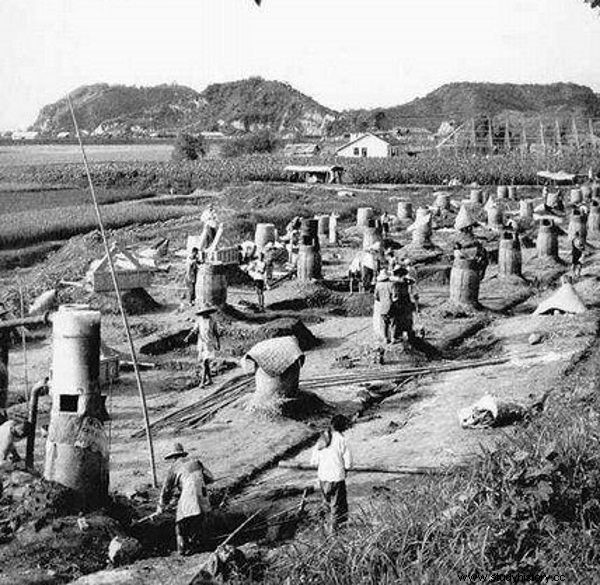
The experiment involving, among other things, smelting steel in home gardens ended in the greatest famine in the 20th century.
Hunger - which was the greatest disaster of this type in the 20th century - was only gradually overcome in the years 1962-1965. The Chinese authorities have been forced to buy food from third countries. The effects of the Great Leap Forward, however, were felt for a long time. Even in the fall of 1962, even the people of Beijing were malnourished. As many as a third of the employees showed symptoms of a protein deficiency on a national radio station. "They were lethargic and swollen, their skin was covered with dark patches." - describes Torbjørn Færøvik - “those who came to work wandered between desks, touching their colleagues' cheeks with their fingers. If the skin did not return to the site immediately, it was a sign of swelling. "
Due to the economic disaster caused by the Great Leap Forward, Chairman Mao was temporarily removed from power in the 1960s by Liu Shaoqi, Chen Yun and Deng Xiaoping. However, he returned in the same decade with another action. This time it was about tracking political opponents within the party and the nation - the Great Proletarian Cultural Revolution. She, too, surpassed the wildest expectations of a Chinese tyrant…
Cannibalism as a form of revenge
Mao perfectly understood the realities of previous eras and skilfully used the patterns he found in classical Chinese texts. When he was sidelined, he skillfully fueled interest in himself. He made him feel absurdly adored in the country.
In 1965, the Chinese economy finally returned to its 1957 production state. China was on a slow growth path. It was at this point that the chairman chose to unleash the struggle against the class enemy. After all, as he stated: "Counter-revolution is everywhere. There is class struggle everywhere ” . His campaign began on August 18, 1966.
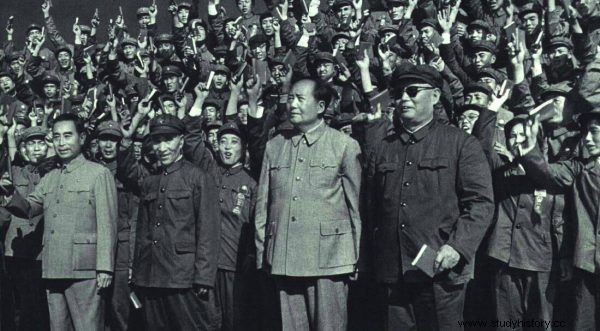
Despite the defeat of the Great Leap Forward, Mao still had crowds of fanatical followers. Photo from November 1966.
More than 200,000 Red Guard members then gathered in Heavenly Peace Square, promising to bring about a complete "cultural" change in China. They swore absolute obedience to Mao. The police were instructed not to interfere in their activities. Any attempt to stop them was considered "counter-revolutionary."
In the first month of the Cultural Revolution inaugurated in this way, in Beijing alone, troops of young, hateful Red Guards plundered nearly 150,000 homes. 1,772 people were killed. About 77,000 were forcibly dragged out of their own homes. 2.3 million books and 3.3 million works of art were confiscated.
A spiral of violence took place across the country and continued for the next several years. As Torbjørn Færøvik notes in his book Mao. The Empire of Suffering ":
In the fall of 1967, new revolutionary committees were established, and a year later there were even more. But the violence did not stop. In some parts of the country, it has become even more brutal. Subsequent killings and mass murders were committed in many provinces, and murderers who could not be controlled by anyone completed their crimes by eating their victims. [...] During the great leap, the Chinese ate the Chinese of poverty. Now cannibalism has become a form of revenge.
"Kill me before you cut him off"
The accounts of the witnesses of these events prove that a regular civil war was fought in the Middle Kingdom. The winning side had no mercy for the defeated. Earlier punishments for counter-revolutionaries, such as public humiliation, prison sentences or work in the penal ward, were considered too lenient by Mao fanatics. There were bloody performances everywhere, including eating human flesh.
He described one of the bestial acts of triumph over the "enemies of the people" in Luxin in his famous book, Scarlet Memorial. Tales of Cannibalism in Modern China ”Zheng Yi. The events took place in front of the state grain warehouse. Two boys fell victim to the revolution and they were cut out while they were still alive.
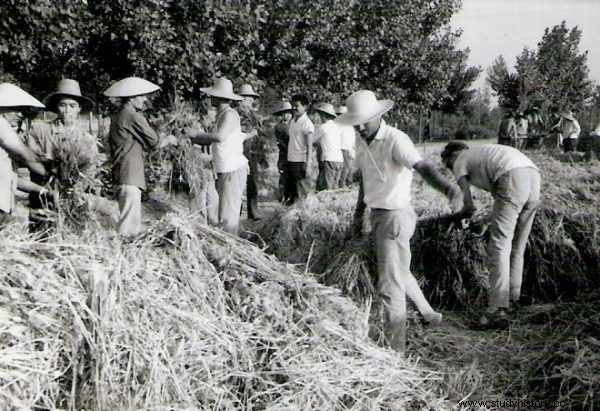
The cultural revolution affected not only the inhabitants of larger cities, but also the population of the provinces. The photo shows Chinese farmers during the revolution.
The operation was carried out by the caretaker of the local school. “Holding the knife in his right hand, he carved out the heart and liver. It was said that the meat was later cooked together with the pork and divided among those present at the seat of the provincial authorities, ”the author relates. In turn, Torbjørn Færøvik describes:
One of the production brigades in the Tongwan area has a Gan Kezing named as a victim. He was still alive when the perpetrators began the nobility by cutting off his penis. "Kill me before you cut him off," he cried, but in vain. It was cut into small pieces. When the torturers had the tastiest morsels, that is, the heart, liver and penis, the others rushed to the rest of the body like hungry wolves.
At the same time, four men were killed at a damnation rally in Sanli. Later their bodies were cooked in huge cauldrons. "Twenty or thirty people" attended the feast held that evening in front of the commune headquarters in Shangjiang.
The author of the book “Mao. The Empire of Suffering "also reports that in Guangxi Province in the summer of 1968, all the" losers "were killed and eaten! A real cannibalistic feast organized by young revolutionaries in Wuxuan is also recalled by Zheng Yi:"When the condemnation session was over, the victims were ripped alive and all their parts - the heart, lungs, bladder, kidneys, elbows, feet and intestines - were boiled, baked or fried ". In his opinion, such meetings where people were entertained by eating human flesh and drinking a lot "happened almost every day.
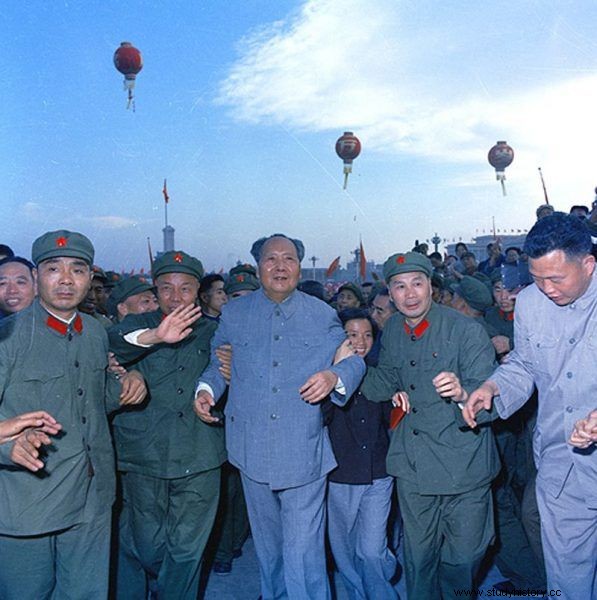
Terror reigned in the provinces, and Mao celebrated the success of the Great Proletarian Cultural Revolution. Photo from autumn 1966.
It got to the point that in the provinces it was even believed that cannibalism had healing properties. "The visually impaired woman who heard that she could regain her sight if she eats the eyes of the dead went from body to body and gouged out the eyes of the corpses," proves Færøvik.
This true face of the Great Proletarian Cultural Revolution is still being discovered today. Cannibalism appears to have become commonplace during the mass hysteria unleashed by Mao. The chairman himself, responsible for one or two waves of cannibalism in his own country, never suffered the consequences of his actions. Even today, many people fondly remember the times of his rule ...
Bibliography:
- Nathan Constantine, A History of Cannibalism , Bellona 2007.
- Torbjørn Færøvik, Prószyński i S-ka 2018.
- Pin Ho, Wenguang Huang, Hit the Black , Black 2015.
- Zheng Yi, Scarlet Memorial. Tales of Cannibalism in Modern China , Boulder 1996.
